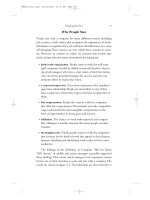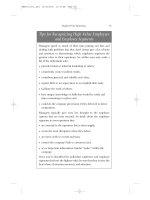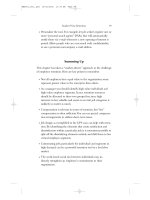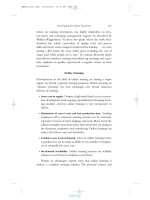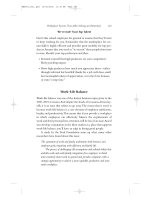Hammer and silicon the soviet diaspora in the US innovation economy
Bạn đang xem bản rút gọn của tài liệu. Xem và tải ngay bản đầy đủ của tài liệu tại đây (4.82 MB, 435 trang )
Hammer & Silicon: The Soviet
Diaspora in the US Innovation
Economy
Immigration, Innovation, Institutions, Imprinting,
and Identity
This deeply personal book tells the untold story of the significant
contributions of technical professionals from the former Soviet Union to
the US innovation economy, particularly in the sectors of software, social
media, biotechnology, and medicine. Drawing upon in-depth interviews, it
channels the voices and stories of more than 150 professionals who
emigrated from 11 of the 15 former Soviet republics between the 1970s
and 2015, and who currently work in the innovation hubs of Silicon Valley
and Boston-Cambridge. Using the social science theories of institutions,
imprinting, and identity, the authors analyze the political, social,
economic, and educational forces that have characterized Soviet
immigration over the past 40 years, showing how the particularities of
the Soviet context may have benefited or challenged interviewees’ work
and social lives. The resulting mosaic of perspectives provides valuable
insight into the impact of immigration on US economic development,
specifically in high technology and innovation.
Sheila M. Puffer is University Distinguished Professor and Professor of
International Business and Strategy at the D’Amore-McKim School of
Business, Northeastern University, Boston, USA. She served as Program
Director of the Gorbachev Foundation of North America, and is an
Associate at the Davis Center for Russian and Eurasian Studies at
Harvard University. Business and management in the former USSR are a
major focus of her 160 publications, including Behind the Factory Walls:
Decision Making in Soviet and US Enterprises.
Daniel J. McCarthy is University Distinguished Professor and the Alan S.
McKim and Richard A. D’Amore Distinguished Professor of Global
Management and Innovation at the D’Amore-McKim School of Business,
Northeastern University, Boston, USA. He is also an Associate at the Davis
Center for Russian and Eurasian Studies at Harvard University. He has
over 110 publications, including four editions of Business Policy and
Strategy, as well as Business and Management in Russia, The Russian
Capitalist Experiment, and Corporate Governance in Russia.
Daniel M. Satinsky is an attorney, business consultant, and independent
scholar, and an Associate at the Davis Center for Russian and Eurasian
Studies at Harvard University. He served as Board President of the USRussia Chamber of Commerce of New England, Inc., from 2001 to 2016.
He is editor of the Buyer’s Guide to the Russian IT Outsourcing Industry
and author of Industrial Giants, Entrepreneurs, and Regional
Government: The Changing Business Environment in Yaroslavl’ Oblast,
1990–1999, amongst other publications.
Hammer & Silicon:
The Soviet Diaspora in
the US Innovation
Economy
Immigration, Innovation, Institutions,
Imprinting, and Identity
sheila m. puffer
D’Amore-McKim School of Business, Northeastern University
daniel j. mccarthy
D’Amore-McKim School of Business, Northeastern University
daniel m. satinsky
Business Consultant and Independent Scholar
University Printing House, Cambridge CB2 8BS, United Kingdom
One Liberty Plaza, 20th Floor, New York, NY 10006, USA
477 Williamstown Road, Port Melbourne, VIC 3207, Australia
314–321, 3rd Floor, Plot 3, Splendor Forum, Jasola District Centre,
New Delhi – 110025, India
79 Anson Road, #06–04/06, Singapore 079906
Cambridge University Press is part of the University of Cambridge.
It furthers the University’s mission by disseminating knowledge in the pursuit of
education, learning, and research at the highest international levels of excellence.
www.cambridge.org
Information on this title: www.cambridge.org/9781107190856
DOI: 10.1017/9781108120302
© Sheila M. Puffer, Daniel J. McCarthy, and Daniel M. Satinsky 2018
This publication is in copyright. Subject to statutory exception
and to the provisions of relevant collective licensing agreements,
no reproduction of any part may take place without the written
permission of Cambridge University Press.
First published 2018
Printed in the United States of America by Sheridan Books, Inc.
A catalogue record for this publication is available from the British Library.
Library of Congress Cataloging-in-Publication Data
Names: Puffer, Sheila M., author. | McCarthy, Daniel J., author. |
Satinsky, Daniel M., author.
Title: Hammer and silicon : the Soviet diaspora in the US innovation,
economy : immigration, innovation, institutions, imprinting, and
identity / Sheila M. Puffer, Northeastern University, Boston,
Daniel J. McCarthy, Northeastern University, Boston, Daniel M. Satinsky,
Foresight Science & Technology, Inc.
Description: New York : Cambridge University Press, 2018.
Identifiers: LCCN 2017055513| ISBN 9781107190856 (hardback) |
ISBN 9781316641262 (paperback)
Subjects: LCSH: Technological innovations – United States. | Former
Soviet republics – Emigration and immigration. | United States – Emigration
and immigration. | BISAC: BUSINESS & ECONOMICS / Entrepreneurship.
Classification: LCC HC110.T4 P84 2018 | DDC 338/.0640973–dc23
LC record available at />ISBN 978-1-107-19085-6 Hardback
ISBN 978-1-316-64126-2 Paperback
Cambridge University Press has no responsibility for the persistence or accuracy of
URLs for external or third-party internet websites referred to in this publication
and does not guarantee that any content on such websites is, or will remain,
accurate or appropriate.
To the 157 interviewees and their families who made the bold
journey to the United States, and to the legions of others like
them from all corners of the world. – With admiration from the
authors
To my family – Douglas and Annika, Carol and Dorian, all of
whose parents include immigrants. – SMP
To my family for their enduring love and support. – DJM
To my wife, Dinah, for her patience, encouragement, and
support through the years. – DMS
Contents
Foreword
page ix
Acknowledgments
xii
About the Authors
xv
Introduction
1
Part I
19
1
2
3
4
Analytical Framework
Theoretical Foundations: Institutions, Imprinting,
and Identity
21
Soviet Political, Economic, and Social Institutions:
Catalysts for Migration
35
Soviet Educational Institutions: Capability
for Contribution
65
Migration from the Former Soviet Union to the United
States: Three Waves 1972–2015
105
Part II The Immigrants’ Experiences, Integration,
and Contributions
149
Entrepreneurial Spirit, Creativity, and Innovativeness:
Startups in the United States
151
Research, Development, and Applications in Academic
and Industry Settings
199
7
Cultural Adaptation: Challenges and Sources of Support
238
8
Workplace Adaptation: Developing Soft Skills
277
9
Identity: A Constellation of Influences
323
5
6
vii
viii
Contents
Part III Conclusion
371
10 The Impact of Institutions, Imprinting, and Identity
on the Immigration and Innovation Process
373
Index
396
Foreword
Hammer & Silicon is a model of social science research, but its subject
matter would also make for a great novel. The book juxtaposes two
places that are literally “worlds apart:” the Soviet communist regime
during its decline, collapse, and subsequent disintegration (the
Hammer) and the dynamic regions of entrepreneurship and
innovation that emerged at roughly the same time in the US (the
Silicon). The protagonists of this unlikely collision – and the focus of
this fascinating book – are the highly educated scientists and engineers
who left the Soviet Union and settled in Silicon Valley and the BostonCambridge areas in the late twentieth and early twenty-first centuries.
The book’s authors, all established scholars of Russian studies,
interviewed 157 members of the Soviet diaspora. The interview
results provide a rich tapestry of individual trajectories that differ due
to ethnic, cultural, and family circumstances, but nevertheless
accumulate to illuminate strong cross-cutting themes at the core of
the book. We learn that the earliest Soviet immigrants to the US
beginning in the 1970s were refugees escaping virulent anti-Semitism,
or, in later years, the economic dislocations following the collapse of
the Soviet Union. Only more recently have Russian-speaking
immigrants come to the US seeking additional education and/or
economic opportunity. This latter wave has more in common with
the Asian immigrants who typically come to the US for higher
education, and then stay on to work in fast-growing technology
regions.
Some of the most engaging parts of the book are the first-hand
accounts, mostly in the words of immigrants themselves, of the
experience of being raised in the former Soviet Union (with its
authoritarian and bureaucratic institutions, pervasive dissembling
and cynicism, distrust of business, and highly personalized trust) and
adapting to the US and to technology centers (where entrepreneurship
is a social good and work is organized around teams, collaboration,
ix
To the 157 interviewees and their families who made the bold
journey to the United States, and to the legions of others like
them from all corners of the world. – With admiration from the
authors
To my family – Douglas and Annika, Carol and Dorian, all of
whose parents include immigrants. – SMP
To my family for their enduring love and support. – DJM
To my wife, Dinah, for her patience, encouragement, and
support through the years. – DMS
Foreword
xi
infrastructure takes decades, but the alternative for any country is to
fall further behind in the global economy.
Hammer & Silicon doesn’t dwell on this, but the book provides
ample evidence that the Russian-speaking Argonauts have become
part of an international technical community that circulates among
dynamic regions in the US, Asia, and Europe. Soviet diaspora members
have seeded technology activity in Ukraine, Russia, Lithuania,
Romania, Armenia, Estonia, and others, providing employment,
technical know-how, advice, funding, and other opportunities for
their home-country counterparts. In short, the mobility of highly
educated workers–which depends on keeping national borders open–
provides benefits to regions around the world. Even places that seem as
unlikely as the former Soviet Union.
AnnaLee Saxenian
Dean and Professor, School of Information
Professor, Department of City and Regional Planning
University of California, Berkeley
Acknowledgments
We begin our acknowledgments by recognizing that we owe a huge
debt to the eminent scholars whose work has informed our own over
the past several decades. Among them are the legendary Sovietologists
Joseph Berliner, Abram Bergson, and Marshall Goldman, who were
regular attendees at the Economics Luncheon Seminar organized at
Harvard University’s Davis Center for Russian and Eurasian Studies
where we three authors continue to be Center Associates. We have
learned a great deal from them as well as from the dozens of scholars
who presented their work there over the past three decades. We also
owe a tremendous debt to Loren Graham of MIT and Irina Dezhina of
Skolkovo Institute of Science and Technology for their work on Soviet
science and the 1990s brain drain from that country.
As with any successful book project, beyond the authors and, in this
case, even beyond the interviewees, there were numerous contributors
who in various ways played key roles in the successful completion of
this book. We acknowledge here the many individuals, groups, and
institutions that played important roles for which we authors are
extremely grateful while recognizing that the responsibility for the
book’s content remains with us.
We first thank the team of transcribers of the 157 interviews, the
major transcribers being Northeastern University research assistants
Ryan Donohue and Jacklyn Gronau, as well as professional transcriber
Daina Krumins. Other Northeastern students who provided
transcription services were Veronique Falkovich, Lily Gacicia, Ruth
Leifer, Alina Samarova, and Rachael Volpert. Ryan Donohue also
provided the majority of research assistance involved with analyzing
transcripts, while other Northeastern students, Jacklyn Gronau and
Rohit Kogta, provided additional assistance. D’Amore-McKim School
of Business staff members who provided administrative support were
Jenny (Evgeniia) Bagnyuk, Magda Drici, Michael Marafitte, Grace
xii
Acknowledgments
xiii
Oliveira, and Oxana Tkachenko. Other sources of support important
to completing this book are D’Amore-McKim colleagues former Dean
Hugh Courtney, Senior Associate Dean Emery Trahan, and Group
Coordinators Christopher Robertson of the International Business
and Strategy Group and Marc Meyer of the Entrepreneurship and
Innovation Group. Colleagues at Stanford University Graduate
School of Business were also instrumental in sponsoring Sheila
Puffer’s sabbatical there from January to September 2015, including
Senior Associate Dean for Academic Affairs, Madhav Rajan, and
especially Professor Charles O’Reilly. We also acknowledge
University of California, Berkeley, Dean AnnaLee Saxenian for her
encouragement to us in adding to the literature on immigrant
technical professionals in the United States.
In addition to the many interviewees who provided referrals to other
interviewees, we would like to especially thank Anna Dvornikova, Maria
Eliseeva, and Evgeny Zaytsev, who provided referrals to numerous
interviewees, as well as Kate Carleton, Walter Chick, Ivan Correia,
Douglas Fraser, Ingrid Larsson, Peter Larsson, Bob Nelson, Lindsey
Sudbury, Martina Werner, and Maury Wood. We also thank others
who provided background insights based on their association with
technical professionals both in the United States and in the former USSR.
They are Dmitry Dakhnovsky, Ekaterina Evstrateyva, Tatiana Fedorova,
Richard Golob, Alexander Ivanov, Julia Ivy, Anna Lamin, Peter
Loukianoff, Tatiana Lysenko, Mykola Lysetskiy, Katia Epshteyn
Ostrovsky, Olga Rodstein, Maxim Russkikh, Paul Santinelli, Amir
Sharif, Joel Schwartz, and Vera Shokina. We are also indebted to those
who provided ideas and insights for the book title and cover design: Ralph
Dinneen, Annika Fraser, Douglas Fraser, Liane Middleton, Marlene
Puffer, and Maury Wood, and we gratefully acknowledge Carol Fraser
and Dorian Scheidt for creating the map of interviewees’ birthplaces.
We would also like to acknowledge that our work was facilitated by
attending and networking at events and conferences sponsored by
various organizations and associations, including the American
Business Association of Russian-Speaking Professionals (AmBAR),
the Global Technology Symposium, the Davis Center for Russian and
Eurasian Studies at Harvard University, New England RussianSpeaking Entrepreneurs (NERSE), Silicon Valley Open Doors, the
US–Russia Business Council, and the US–Russia Chamber of
Commerce of New England.
xiv
Acknowledgments
We extend our deepest and most heartfelt thanks to the 157 people
who devoted their valuable time to be interviewed, usually for one to two
hours and sometimes longer. We owe a great debt to them for their
willingness to trust us, to answer our specific questions, and to share
their stories candidly and willingly. Additionally, we thank them for
having done so in English rather than in their native languages. We hope
the interview experience was valuable for our interviewees, perhaps
giving them an opportunity to reflect on their lives and gain insights
and perspectives about themselves. As interviewee Alexei Masterov said:
“I feel like I’m learning something about myself in the process of this
conversation because I never spoke about it this way, especially in
English. So it’s interesting.” We also hope that the interviewees gain
insights not only from reflecting on their own experiences, but also from
the shared experiences of all 157 interviewees included in this book, and
that they can appreciate the commonalities and differences among their
compatriots who shared having been born in the former Soviet Union
before becoming contributors to the US innovation economy.
We would, of course, be remiss without thanking the Cambridge
University Press team that shepherded our manuscript to successful
completion, including Valerie Appleby, Commissioning Editor for
Business and Management, Assistant Commissioning Editor Stephen
Acerra, Editorial Assistants Kristina Deusch and Toby Ginsberg,
Marketing Executive Ellena Moriarty, Project Manager Sunantha
Ramamoorthy, and Content Manager Bronte Rawlings, as well as
others who reviewed and approved our book proposal and worked
on various aspects of the production and marketing phases to ensure
the quality of our product and its dissemination to institutions and
individuals.
A major project of this type and proportions obviously requires
substantial financial resources to support the numerous activities and
individuals in the many phases of its development and completion.
The Alan S. McKim and Richard A. D’Amore Distinguished
Professorship of Global Management and Innovation provided major
funding for the book. Other sources of funds from Northeastern
University’s D’Amore-McKim School of Business included the
International Business and Strategy Group research fund, the Dean’s
Faculty Travel Fund, and the Center for Emerging Markets.
We acknowledge and thank them all for their generous help in
accomplishing various aspects of this book.
About the Authors
Sheila M. Puffer is University Distinguished Professor and Professor
of International Business and Strategy at the D’Amore-McKim
School of Business, Northeastern University, Boston. She is also
an Associate at the Davis Center for Russian and Eurasian Studies
at Harvard University. In 2015, she was a visiting research professor at the Graduate School of Business at Stanford University where
she interviewed Silicon Valley entrepreneurs and other professionals from the former Soviet Union about their contributions to
the US innovation economy. Dr. Puffer has more than 160 publications, including eighty refereed articles and eleven books. She has
been recognized as the leading scholar internationally in business
and management in Russia, the former Soviet Union, and Eastern
Europe according to a 2005 Journal of International Business
Studies article. She also ranks as the most published author (tied
with coauthor D. McCarthy) in the Journal of World Business from
1993 to 2003. She has been ranked in the top 5 percent of authors
worldwide who published in the leading international business
journals from 1996 to 2005, according to a Michigan State
University study. She is fluent in French and Russian. She earned
a diploma from the executive management program at the
Plekhanov Institute of the National Economy in Moscow, and she
holds a BA (Slavic Studies) and an MBA from the University of
Ottawa, Canada, and a PhD in business administration from the
University of California, Berkeley.
Daniel J. McCarthy is University Distinguished Professor and the
Alan S. McKim and Richard A. D’Amore Distinguished Professor
of Global Management and Innovation at the D’Amore-McKim
School of Business, Northeastern University, Boston, and is also
an Associate at the Davis Center for Russian and Eurasian Studies
at Harvard University. He is cofounder, codirector, and chair of
the strategy advisory council of Northeastern’s Center for
Entrepreneurship Education. Additionally, he is cofounder of
xv
xvi
About the Authors
the Northeastern University Venture Mentoring Network and
a member of the steering committee, as well as a board member
for IDEA, the Northeastern University Venture Accelerator.
Dr. McCarthy has more than 110 publications, including four
editions of Business Policy and Strategy, as well as Business and
Management in Russia, The Russian Capitalist Experiment, and
Corporate Governance in Russia. He served as the lead director
of Clean Harbors, Inc., a multibillion dollar NYSE-listed company, and has consulted in North America and Europe for more
than forty companies. Early in his career, he was cofounder and
president of a public company, Computer Environments
Corporation, and served as a director on its board and also on
the board of its sister public company, Time Share Corporation,
as well as on a number of private company and nonprofit boards.
Dr. McCarthy ranks as the most published author (tied with
coauthor S. Puffer) in the Journal of World Business from 1993
to 2003, and he has been ranked in the top 5 percent of all
authors worldwide who published in the leading international
business journals from 1996 to 2005, according to a Michigan
State University study. He is also one of the top three scholars
internationally in business and management in Russia and
Central and Eastern Europe, based on a Journal of International
Business Studies article analyzing publications in thirteen leading
journals from 1986 to 2003. Professor McCarthy holds AB and
MBA degrees from Dartmouth College and the Tuck School of
Business, and a DBA from Harvard University.
Daniel M. Satinsky is a business consultant and independent scholar.
For more than twenty years, he has provided market entry and
commercialization services to Russian and US technology companies. In this capacity, he has traveled extensively throughout Russia
and the former Soviet Union. He has also written and spoken on
topics related to business, innovation, and technology. Selected publications include Industrial Giants, Entrepreneurs and Regional
Government – The Changing Business Environment in the
Yaroslavl’ Oblast 1991–98; he is coauthor of a New York
Academy of Sciences study of worldwide innovation best practices
and their application to Russia, Yaroslavl Roadmap 10–15-20, and
editor of Buyer’s Guide to the Russian IT Outsourcing Industry. He
served as President of the Board of the US–Russia Chamber of
About the Authors
xvii
Commerce of New England for more than fifteen years, and is an
Associate at the Davis Center for Russian and Eurasian Studies at
Harvard University. He holds a Master of Law and Diplomacy
degree from the Fletcher School of Law & Diplomacy at Tufts
University, a JD from Northeastern University Law School, and
a BA from James Madison College of Michigan State University.
Map 1 Birthplaces of Interviewees in the Former USSR
Map developed by Carol Fraser and Dorian Scheidt using Tableau Maps,
© 2018. www.tableau.com. Used with permission. Birthplaces added by the
authors.
Map 1 (cont.)
Map 2 Birthplaces of Interviewees: Detail of the Western Region of the Former
USSR
Map developed by Carol Fraser and Dorian Scheidt using Tableau Maps, © 2018.
www.tableau.com. Used with permission. Birthplaces added by the authors.
Map 2 (cont.)
Introduction
“Immigrants. We get the job done.”1
This quote from the hit Broadway show, Hamilton: The Musical,
epitomizes one of the core American portrayals of immigrants as hardworking people who come to the United States seeking economic,
social, and personal opportunities and who are willing to work hard
to achieve their goals. In the musical, the characters depicting
Alexander Hamilton and Marquis de Lafayette were referring to immigrants at the time of the American Revolution nearly 250 years ago.
Today, immigrants are currently the topic of intense controversy, with
competing political narratives regarding their role in the US economy.
One often neglected element in this controversy is the tremendous
contribution to the US technology sector that has come from immigrants, particularly those who came after the Immigration Reform Act
of 1965. These contributions have been well recognized in industry, as
evidenced by the recent establishment of two organizations founded by
prominent leaders of US technology companies advocating for immigration policies that would continue attracting and retaining scientific
and technical professionals from abroad. One group, FWD.us, was
founded by high-profile technology executives including Mark
Zuckerberg of Facebook, Bill Gates of Microsoft, and Marissa Mayer
of Yahoo. Another is Partnership for a New American Economy whose
founders include former Microsoft CEO Steve Ballmer and former
New York City mayor Michael Bloomberg who heads the huge diversified business communications company, Bloomberg L.P.
This book, Hammer & Silicon: The Soviet Diaspora in the US
Innovation Economy, presents the story of one specific group of immigrants who were part of the global migration of talent attracted to the
United States in the later decades of the twentieth century and early part
1
Lin-Manuel Miranda, Yorktown (The World Turned Upside Down). From
Hamilton: The Musical (New York: Grand Central Publishing, 2015).
1
2
Introduction
of the twenty-first century after US immigration reform. This talent
pool helped fuel US economic growth and world leadership in high
technology. Presented in this book are immigrants from the former
Soviet Union who tell their stories of their generally unrecognized role
in this era of US technology leadership.
About the Title
The title of this book incorporates two of the most powerful symbols of
the twentieth century, one associated with the Soviet Union and the
other with the United States. The hammer and sickle is well-known as
the symbol of the USSR, and the silicon chip is widely used as a symbol
of the high-technology industry in the United States. The full title of the
book points to the emigration and brain drain before, and particularly
during, the collapse of the Soviet Union and its impact on US science
and technology. This process is illustrated through interviews with a
remarkable and talented group of individuals who came to the United
States and who ended up becoming significant contributors to the US
technology sector.
The Soviet hammer of industry and sickle of agriculture were the
symbolic representation of the forced transformation that turned the
Russian Empire of the nineteenth-century czars into a world power.
That symbol was intended to represent the worker–peasant alliance of
social forces in an idealized depiction of the Soviet Union. As such, that
symbol represented the command or centrally planned economy of the
Soviet state and was ubiquitous in the country’s flag, documents, uniforms, and government buildings. In the post–World War II world, the
Soviet Union began to emerge as a technological rival to the United
States, particularly with the launch of the Sputnik space satellite in
1957. It was a rival with enormous human capital in science, engineering, and mathematics, one that was institutionalized in a network of
state-financed universities, research institutes, laboratories, and specialized enterprises.
A major US response to this technological threat was the silicon chip,
which became the building block of a transformational technological
era. In the 1950s, the Santa Clara Valley on the San Francisco peninsula
was the birthplace of the silicon chip, or silicon-based integrated circuit, and was the home of the world’s first silicon chip producer,
Fairchild Semiconductor. The Soviet satellite launch was the impetus
